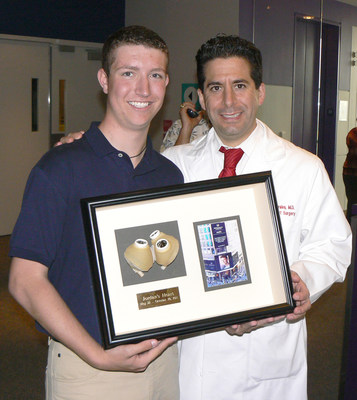1st Use Of The SynCardia Systems, Inc. Total Artificial Heart In A 17-Year-Old Congenital Heart Disease Patient At Pediatric Hospital
TUCSON, Ariz., Sept. 23, 2014 /PRNewswire/ -- A case report and matching animated video demonstrate the successful implantation of a SynCardia temporary Total Artificial Heart into a patient with congenital heart disease where his major arteries and ventricles were reversed, along with other abnormalities.

The report and video in the Journal of Visualized Experiments show that "the [SynCardia Total Artificial Heart] is feasible even in patients with structurally abnormal hearts," say authors Dr. Iki Adachi, pediatric congenital heart surgeon at Texas Children's Hospital and assistant professor of surgery in the division of congenital heart surgery at Baylor College of Medicine, and Dr. David S.L. Morales, chief of cardiothoracic surgery at the Heart Institute at Cincinnati Children's Hospital Medical Center and the implanting surgeon while a pediatric congenital heart surgeon at Texas Children's.
The case report published July 18, 2014 describes a 17-year-old male with congenitally corrected transposition of the great arteries (CCTGA), pulmonary atresia and ventricular septal defect (VSD). He had an ascending aorta to main pulmonary artery shunt and epicardial pacemaker placed in infancy.
He was admitted to the hospital with worsening heart failure that quickly led to kidney failure and end-stage biventricular heart failure in which the two native ventricles no longer could pump enough blood for the patient to survive.
"Although the [SynCardia Total Artificial Heart] is designed for individuals with normally structured hearts," according to the case report, "the device was considered the patient's best option for survival considering the severity of his condition and the presence of complex cardiac lesions."
"There are certaincongenital heart patients who have multiple defects and established biventricular failure," Morales says. "It would be much easier to take out the whole heart and only do one procedure, which is the placement of the SynCardia Total Artificial Heart, than repair multiple defects in order to place a VAD (ventricle assist device)."
Morales modified the SynCardia Total Artificial Heart so that the right and left pumps were implanted parallel to each other instead of the normal crisscross arrangement.
The video animation shows the removal of the diseased heart and the implantation of the SynCardia Heart, including the details of the modification required for the aorta and pulmonary arteries.
Like a heart transplant, the SynCardia Total Artificial Heart is the only approved device that replaces the two failed ventricles and the four heart valves to eliminate the source of biventricular heart failure. The SynCardia Heart is used as a bridge to transplant to a matching donor heart.
Texas Children's was the first pediatric hospital in the United States to implant this device as the only option to save the patient's life. Three months following the implant surgery, the patient was able to go home on the Freedom® portable driver, which allows clinically stable patients to be discharged from the hospital to wait for their matching donor heart at home and in their communities.
"The patientwas able to return home and regain health and strength prior to being successfully bridged to [a donor heart transplant] five months after receiving the [SynCardia Total Artificial Heart]," the report notes.
At the end of the video, the patient is identified as Jordan Merecka. A companion video shows recent interviews of Merecka and his parents giving their thoughts on the SynCardia Total Artificial Heart and Jordan's experience. "This is just an amazing piece of technology," Susan Merecka says in the video. "The night of May 23 [2011] we were so thankful that that technology was available."
The case report makes several conclusions about the SynCardia Total Artificial Heart.
- While patients with malformed hearts previously were not candidates for SynCardia Heart implantation, this case proves that with modification, the SynCardia Heart is a viable option for patients with CCTGA.
- The SynCardia Heart may be a simpler solution than using ventricular assist devices (VADs) in patients with end-stage complex congenital heart disease and heart failure.
- As more children with congenital heart disease survive into adulthood, the SynCardia Total Artificial Heart provides an additional option for these patients who may eventually suffer from heart failure.
"This case should represent the beginning of the new era of mechanical circulatory support for those with malformed hearts," the report concludes.
For additional information, please visit: http://www.syncardia.com/
- Like SynCardia on Facebook
- Follow SynCardia on Twitter @SynCardia
- Connect with SynCardia on LinkedIn
- Share and Discover on Google+
About the SynCardia temporary Total Artificial Heart
Photo - http://photos.prnewswire.com/prnh/20140922/147715
SOURCE SynCardia Systems, Inc.
